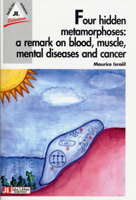(for any order > 35€)
This book of biology and medicine shows how diseases: Sickle cell anemia, Duchenne muscular dystrophy, are related to the adaptation of our organism to aerial respiration. This adaptation is operated by a genetic switch substituting a set of fetal proteins, for more adequate, regulated, adult isoforms. We discover how fetal or adult metabolic pathways, may control the switch, and propose pharmacological treatments to boost the expression of the fetal gene, acting as a ”spare wheel” to replace the adult gene when it is mutated. In fact this switch recapitulates a process reminding of the evolution of amphibians that left their pond to live in air and land. The fetus is also an aquatic creature that discovers at birth aerial respiration and the new weight of his body. His blood and muscle proteins will adapt. The metamorphosis is not as evident as for a tadpole, but still as deeply written in our genes. In fact, the switch is our second metamorphosis, the story started much earlier, when a host cell, already surviving oxygen, incorporated a bacteria, our future mitochondria, that had a more efficient oxidative metabolism. A symbiotic arrangement followed. In the course of development, the most ancient pathways come on stage first, followed by the most recent mitochondrial acquisitions. The developmental maturation of metabolic pathways changes our cells, it is our first metamorphosis. It is involved in apoptosis in diseases such as Azheimer’s or Cancer. Since mitochondria took the burden of making ATP, the ancient oxidative mechanism became redundant. Its ATPase evolved forming acidic compartments that control neurotransmission or thermoregulation. This third metamorphosis is implicated in other diseases (adrenoleucodystrophy). Finally primates, who lost uricase, developed diseases related to the role of uric acid which became their new antioxidant: Gout, Autism or Schizophrenia seem to depend on this last, forth metamorphosis.
Contents :
Life in oxygen, the invention of respiration and communication
A hidden metamorphosis
Oxidative metabolism Mitochondrial – Acid Vacuole Interactions
The interface of oxygen and nitrogen metabolism: nitrosylated compounds and methylations
Epilogue
References
